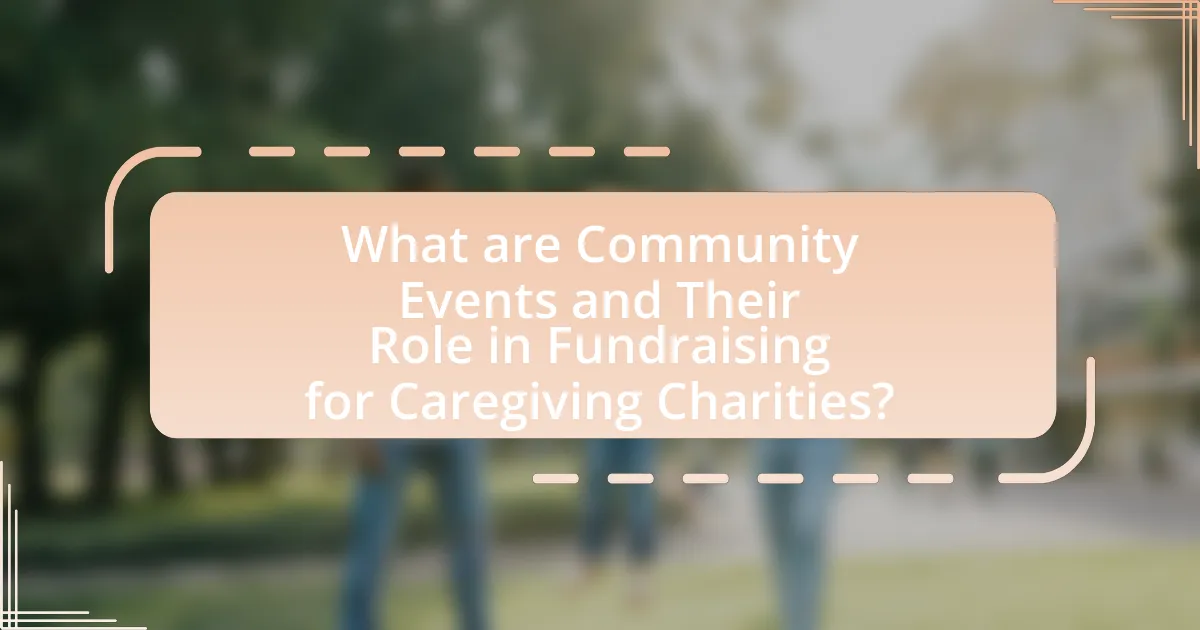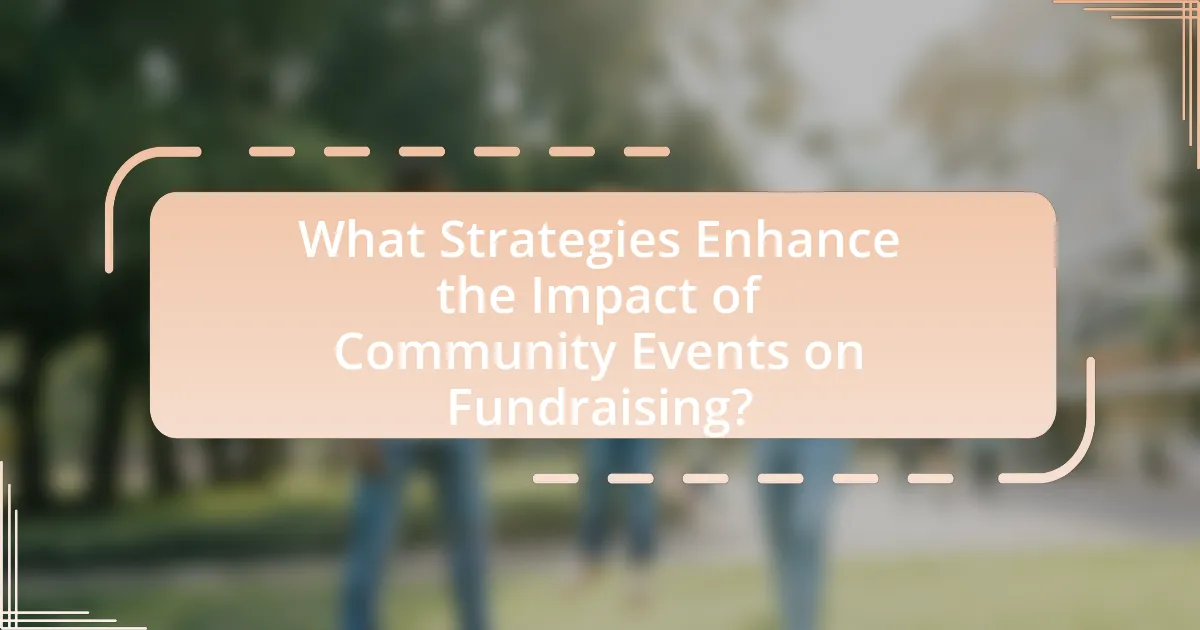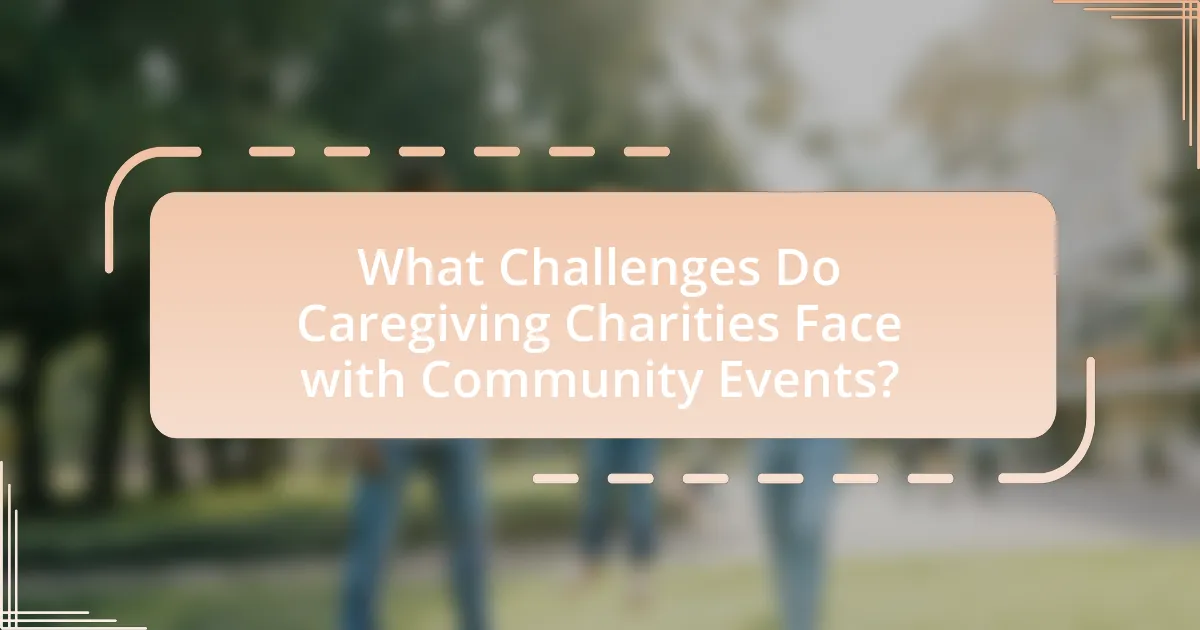Community events play a crucial role in fundraising for caregiving charities by engaging local populations and raising awareness and financial support. These events, including charity runs, bake sales, and community fairs, can account for a significant portion of total fundraising revenue, enhancing visibility and encouraging direct participation from attendees. Effective community events foster relationships between charities and donors, increase awareness of caregiving issues, and can lead to higher fundraising outcomes through strategic marketing and community engagement. Challenges such as limited funding and volunteer shortages can impact event success, but leveraging partnerships and employing best practices can enhance the effectiveness of these fundraising efforts.

What are Community Events and Their Role in Fundraising for Caregiving Charities?
Community events are organized gatherings that engage local populations to raise awareness and funds for caregiving charities. These events, such as charity runs, bake sales, and community fairs, serve as platforms for fostering community spirit while generating financial support for caregiving initiatives. According to a study by the Association of Fundraising Professionals, community events can account for up to 30% of total fundraising revenue for charities, highlighting their significant role in sustaining caregiving programs. By bringing people together, these events not only enhance visibility for caregiving causes but also encourage direct participation and donations from attendees, thereby amplifying the impact of charitable efforts.
How do community events contribute to fundraising efforts?
Community events significantly enhance fundraising efforts by fostering engagement and building relationships within the community. These events create opportunities for individuals to connect with the cause, increasing awareness and encouraging donations. For instance, a study by the Association of Fundraising Professionals found that 70% of donors are more likely to give when they feel a personal connection to the cause, which community events facilitate through shared experiences. Additionally, community events often attract local media coverage, further amplifying the fundraising message and reaching a broader audience. This combination of personal engagement and increased visibility directly contributes to higher fundraising outcomes for caregiving charities.
What types of community events are most effective for caregiving charities?
Community events that are most effective for caregiving charities include fundraising walks, benefit concerts, and community fairs. Fundraising walks, such as those organized by the Alzheimer’s Association, have shown to raise significant funds while increasing awareness, with events like the Walk to End Alzheimer’s raising over $500 million since its inception. Benefit concerts attract large audiences and can generate substantial donations, as evidenced by events like the Concert for Valor, which raised millions for veterans’ charities. Community fairs provide a platform for local businesses to sponsor activities, fostering community engagement and raising funds through entry fees and donations. These event types not only raise money but also enhance community awareness and support for caregiving initiatives.
How do community events engage local populations in fundraising?
Community events engage local populations in fundraising by creating opportunities for social interaction and collective participation. These events, such as charity runs, bake sales, and community fairs, foster a sense of belonging and shared purpose among attendees, which can motivate individuals to contribute financially. Research indicates that community events can increase fundraising effectiveness; for instance, a study by the Association of Fundraising Professionals found that events can raise up to 50% more funds compared to traditional fundraising methods. Additionally, local businesses often sponsor these events, further enhancing community involvement and financial support.
Why are community events important for caregiving charities?
Community events are crucial for caregiving charities because they enhance visibility, foster community engagement, and drive fundraising efforts. These events create opportunities for charities to connect with potential donors and volunteers, increasing awareness of their mission and services. For instance, a study by the National Philanthropic Trust found that 70% of donors are more likely to give when they feel a personal connection to the cause, which community events facilitate through direct interaction. Additionally, community events often generate immediate financial support through ticket sales, donations, and sponsorships, significantly boosting the charity’s resources for caregiving initiatives.
What impact do community events have on awareness for caregiving issues?
Community events significantly enhance awareness for caregiving issues by providing a platform for education and engagement. These events often feature workshops, discussions, and informational booths that inform attendees about the challenges faced by caregivers, thereby increasing public understanding and empathy. For instance, a study by the National Alliance for Caregiving found that community outreach initiatives can lead to a 30% increase in caregiver support inquiries, demonstrating a direct correlation between event participation and heightened awareness.
How do community events foster relationships between charities and donors?
Community events foster relationships between charities and donors by creating opportunities for direct interaction and engagement. These events allow donors to meet charity representatives, understand their missions, and see the impact of their contributions firsthand. For instance, a study by the Association of Fundraising Professionals found that personal connections made during events significantly increase donor retention rates, with 70% of donors stating they feel more connected to a charity after attending an event. This personal engagement builds trust and loyalty, encouraging ongoing support and collaboration between charities and their donors.

What Strategies Enhance the Impact of Community Events on Fundraising?
Effective strategies that enhance the impact of community events on fundraising include targeted marketing, engaging storytelling, and leveraging social media. Targeted marketing ensures that the right audience is reached, increasing participation and donations; for instance, research shows that events promoted to specific demographics can see a 30% increase in attendance. Engaging storytelling connects potential donors emotionally to the cause, which can lead to higher donation amounts; studies indicate that narratives about beneficiaries can increase donations by up to 50%. Leveraging social media amplifies event visibility and encourages sharing, which can expand reach and attract new donors; data reveals that events with active social media campaigns can raise 20% more funds than those without.
How can charities effectively plan community events for maximum fundraising?
Charities can effectively plan community events for maximum fundraising by setting clear goals, engaging the community, and utilizing strategic marketing. Establishing specific fundraising targets allows charities to measure success and adjust strategies accordingly. Engaging the community through partnerships with local businesses and organizations fosters a sense of ownership and encourages participation, which can significantly increase attendance and donations. Additionally, employing targeted marketing strategies, such as social media campaigns and local advertising, can raise awareness and attract a larger audience. Research indicates that events with strong community involvement and effective promotion can increase fundraising outcomes by up to 50%.
What are the key elements of a successful fundraising event?
The key elements of a successful fundraising event include a clear purpose, effective marketing, engaging activities, a well-defined target audience, and strong volunteer support. A clear purpose ensures that attendees understand the cause they are supporting, which can increase their willingness to contribute. Effective marketing, utilizing social media and community outreach, can significantly boost attendance and donations. Engaging activities, such as auctions or entertainment, keep participants interested and encourage them to give. Identifying a well-defined target audience allows for tailored messaging that resonates with potential donors. Lastly, strong volunteer support is crucial for event execution, as dedicated volunteers can enhance the experience for attendees and help maximize fundraising efforts. These elements collectively contribute to the overall success of fundraising events, as evidenced by numerous case studies showing increased donations when these factors are prioritized.
How can charities leverage partnerships to enhance event success?
Charities can leverage partnerships to enhance event success by collaborating with local businesses and organizations to increase resources, visibility, and engagement. For instance, partnerships can provide access to venues, sponsorships, and promotional support, which can significantly reduce costs and expand outreach. According to a study by the Nonprofit Finance Fund, organizations that engage in partnerships report a 30% increase in event attendance and fundraising outcomes. This demonstrates that strategic alliances can amplify the impact of community events, ultimately benefiting caregiving charities through enhanced fundraising opportunities.
What role does marketing play in community events for fundraising?
Marketing plays a crucial role in community events for fundraising by effectively promoting the event, attracting participants, and maximizing donations. Through targeted advertising, social media engagement, and community outreach, marketing strategies enhance visibility and encourage attendance, which directly correlates with fundraising success. For instance, a study by the Association of Fundraising Professionals found that events with strong marketing campaigns can increase attendance by up to 50%, leading to higher overall contributions. This demonstrates that well-executed marketing not only raises awareness but also significantly boosts the financial outcomes of community fundraising efforts.
How can social media be utilized to promote community events?
Social media can be utilized to promote community events by creating targeted campaigns that engage local audiences. Platforms like Facebook, Instagram, and Twitter allow event organizers to share event details, create event pages, and use targeted ads to reach specific demographics. According to a study by the Pew Research Center, 69% of adults in the U.S. use social media, making it an effective tool for reaching a broad audience. Additionally, social media enables real-time updates and interactions, fostering community engagement and encouraging sharing among users, which can significantly increase event visibility and attendance.
What are effective ways to engage the community before, during, and after events?
Effective ways to engage the community before, during, and after events include utilizing social media for promotion, creating interactive experiences, and maintaining communication post-event. Before events, organizations can leverage platforms like Facebook and Instagram to share event details, generate excitement, and encourage community participation, which has been shown to increase attendance rates by up to 30%. During events, engaging activities such as live polls or Q&A sessions can enhance participant involvement, fostering a sense of community. After events, sending follow-up emails or surveys helps maintain relationships and gather feedback, which is crucial for future planning and shows attendees their opinions are valued. This multi-faceted approach not only boosts attendance but also strengthens community ties, ultimately benefiting fundraising efforts for caregiving charities.

What Challenges Do Caregiving Charities Face with Community Events?
Caregiving charities face several challenges with community events, including limited funding, volunteer shortages, and logistical issues. Limited funding restricts the ability to organize large-scale events, as many charities operate on tight budgets. Volunteer shortages hinder the execution of events, as these organizations often rely on community support for staffing. Logistical issues, such as securing venues and permits, can complicate event planning and execution. According to a 2021 report by the National Council of Nonprofits, 70% of nonprofits cited fundraising challenges as a significant barrier to successful event planning, highlighting the financial constraints faced by caregiving charities.
What common obstacles do charities encounter when organizing events?
Charities commonly encounter obstacles such as limited funding, volunteer shortages, and logistical challenges when organizing events. Limited funding restricts the scale and quality of events, making it difficult to attract participants and sponsors. Volunteer shortages hinder the ability to execute events effectively, as many charities rely on volunteers for planning and execution. Logistical challenges, including securing venues, permits, and managing event timelines, can lead to complications that affect the overall success of the event. These obstacles can significantly impact the fundraising potential of caregiving charities, as successful events are crucial for generating necessary financial support.
How can charities overcome financial constraints in event planning?
Charities can overcome financial constraints in event planning by leveraging partnerships and sponsorships with local businesses and organizations. Collaborating with these entities can provide financial support, in-kind donations, or shared resources, significantly reducing costs. For instance, a study by the Nonprofit Finance Fund found that 70% of nonprofits reported that partnerships helped them achieve their goals more effectively, demonstrating the tangible benefits of collaboration. Additionally, utilizing volunteer support can further minimize expenses, as volunteers can assist with event logistics, marketing, and execution, allowing charities to allocate funds more efficiently.
What strategies can be employed to ensure volunteer engagement?
To ensure volunteer engagement, organizations can implement strategies such as providing clear roles and responsibilities, fostering a sense of community, and offering recognition and rewards. Clear roles help volunteers understand their contributions, which increases their commitment; studies show that defined expectations lead to higher satisfaction rates among volunteers. Fostering a sense of community through team-building activities enhances relationships and encourages ongoing participation, as evidenced by research indicating that social connections among volunteers improve retention rates. Additionally, recognizing and rewarding volunteers for their efforts, whether through formal awards or simple acknowledgments, has been shown to boost morale and motivation, with surveys revealing that 70% of volunteers feel more engaged when their contributions are appreciated.
How can charities measure the success of community events?
Charities can measure the success of community events by evaluating key performance indicators such as attendance numbers, funds raised, participant engagement, and post-event surveys. Attendance numbers provide a direct measure of community interest and outreach effectiveness, while funds raised indicate the financial impact of the event on the charity’s goals. Participant engagement can be assessed through activities like volunteer involvement and social media interactions, reflecting the event’s ability to connect with the community. Post-event surveys offer qualitative data on attendee satisfaction and suggestions for improvement, which can guide future events. These metrics collectively provide a comprehensive view of an event’s success and its contribution to the charity’s mission.
What metrics should be tracked to evaluate fundraising effectiveness?
To evaluate fundraising effectiveness, key metrics include total funds raised, donor retention rate, cost per dollar raised, and average donation size. Total funds raised provides a direct measure of financial success, while donor retention rate indicates the ability to maintain relationships with supporters, which is crucial for long-term sustainability. Cost per dollar raised assesses the efficiency of fundraising efforts, revealing how much is spent to generate each dollar of revenue. Average donation size offers insights into donor engagement and the effectiveness of solicitation strategies. Tracking these metrics allows organizations to make informed decisions and optimize their fundraising strategies.
How can feedback from participants improve future events?
Feedback from participants can significantly enhance future events by identifying strengths and weaknesses in event execution. When participants share their experiences, organizers gain insights into what aspects resonated well, such as engaging activities or effective communication, and what areas need improvement, like logistical issues or content relevance. For instance, a study by the Event Marketing Institute found that 70% of event planners believe participant feedback directly influences their planning strategies, leading to more tailored and successful future events. This iterative process ensures that events evolve based on actual participant experiences, ultimately increasing engagement and fundraising effectiveness for caregiving charities.
What Best Practices Should Charities Follow for Successful Community Events?
Charities should follow best practices such as thorough planning, community engagement, and effective marketing to ensure successful community events. Thorough planning involves setting clear objectives, budgeting accurately, and selecting appropriate venues, which can significantly enhance event execution. Community engagement is crucial; involving local stakeholders and volunteers fosters a sense of ownership and increases participation. Effective marketing strategies, including social media promotion and partnerships with local businesses, can expand reach and attract more attendees. According to a study by the Nonprofit Research Collaborative, organizations that engage their communities and utilize diverse marketing channels see a 30% increase in event attendance, demonstrating the importance of these best practices.
How can charities create a memorable experience for attendees?
Charities can create a memorable experience for attendees by engaging them through interactive activities and personal storytelling. Engaging activities, such as live demonstrations or hands-on workshops, allow attendees to participate actively, fostering a deeper connection to the cause. Personal storytelling from beneficiaries or volunteers can evoke emotional responses, making the mission relatable and impactful. Research indicates that emotional engagement significantly enhances memory retention, with studies showing that stories can increase information recall by up to 22 times compared to facts alone. By combining interactive elements with compelling narratives, charities can ensure that attendees leave with a lasting impression of their mission and purpose.
What are the key takeaways for planning future community fundraising events?
Key takeaways for planning future community fundraising events include understanding the target audience, setting clear goals, and leveraging local partnerships. Identifying the demographics and interests of the community ensures that the event resonates with potential donors, increasing participation and contributions. Establishing specific fundraising objectives, such as a monetary target or community engagement level, provides a measurable framework for success. Collaborating with local businesses and organizations can enhance resources and visibility, as evidenced by studies showing that community partnerships can increase event attendance by up to 30%. These strategies collectively contribute to more effective and impactful fundraising efforts for caregiving charities.